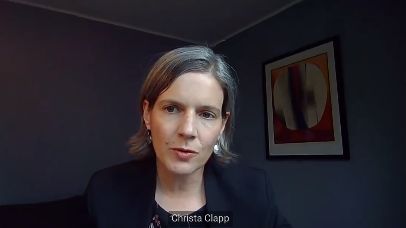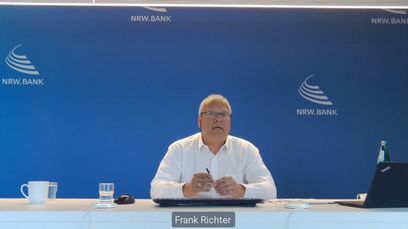KEITH MULLIN, KM CAPITAL MARKETS: CHRISTA, COULD YOU OUTLINE THE KEY THEMES FROM YOUR STANDPOINT AS A SECOND-PARTY OPINION PROVIDER? ALBAN SAID NO INFORMATION IS BAD INFORMATION; I GUESS THAT WOULD GO FOR YOU AS WELL.
Christa Clapp, Cicero Shades of Green: Cicero Shades of Green is an external reviewer. We provide, at the time of issuance, second opinions and green ratings on green and sustainability bonds, and SLBs. And we also follow up with reviews of impact reports. Our methodology is based pretty deeply on climate science and we view our role as providing transparency on climate risk and potential climate environmental impacts.
What Alban was saying about more data is true, but from our viewpoint we also want to make sure that we are looking at the right type of data and understanding it well. More data isn’t necessarily better; it’s actually understanding what the potential impact of that data is with the ambition of the green bond or the SLB, for example.
We had a role to play in setting up the model for external review second-party opinions. We’ve been in the market since 2008, when we provided the first second opinion on the labelled green bond from the World Bank. That’s the model that continues today, where you have an independent reviewer provide checks against greenwashing, a first-level check – not the only check and it doesn’t solve everything.
It’s absolutely best practice today to have an independent reviewer making sure that what the issuer is saying has some truth in it, in terms of being green. We hear from a lot of issuers that think they are the greenest of the green. When we dig into the details, the issuers might be a little less green, or there might be areas to work on. Of course, that’s probably true with every issuer.
Our job is to link it back with the science. Some of the challenges we face are, of course, that at the time of issuance, we know what an issuer is telling us, and we know what the science tells us, and we try to put that together in a package for investors. But what we don’t know is precisely how that bond will be implemented, how those projects will be monitored, managed and reported on.
We have some information about the plans but then we have to make a judgment call, and this is probably one of the biggest challenges we face. We try to reduce some of that uncertainty by including a governance assessment in our methods.

When we review either a use-of-proceeds bond or an SLB, we include this governance assessment, we look at what is the issuer doing in the climate-change environment. Not only what they’re saying in their sustainability reports but what their targets are, how are they measuring towards those targets, and what their policies or internal processes are. Do they have committees with veto power on potentially high-risk environmental projects, for example. Do they look at the emissions from their supply chain and do they try to influence those.
We ask all of these things and put them into an assessment, and it gives us an idea of how well we think an issuer can implement its green ambitions. Of course, this is extremely relevant for sustainability-linked bonds, where you’re also tying in environmental performance with financial performance, and you want to know the direction of the issuer. That’s a challenge in our role in the market; we try to provide transparency on that.
One of the opportunities and an area that we see shifting quite fast is understanding actual impacts, so post-issuance reporting and follow-up. It’s become best practice to have an annual report out to investors but it’s not currently best practice to have that third-party check. The issuer may say the impacts are very nice and lovely, but are they reporting on the things that really matter most to the environment from its projects?
That’s a service that we and others offer. Following on from Alban’s comments, there’s going to be more attention on this on the investor side. Issuers will need to start responding, and we’re happy to play a role there too in starting to check and push against what the bonds are actually achieving. Over the course of the history of the green bond market, the emphasis has been at the time of issuance. I think that’s going to shift; we’re moving into a more mature stage of the market.
KEITH MULLIN, KM CAPITAL MARKETS: LET ME PUT THIS BACK TO THE ISSUERS. OVER THE COURSE OF THE DEVELOPMENT OF THE LABELLED ESG MARKET, THE QUALITY OF REPORTING HAS BEEN A LITTLE BIT ERRATIC. ON THE BASIS THAT THERE’S MUCH MORE OF A REQUIREMENT TO CREATE SCIENCE-BASED TARGETS, AND FOR THERE TO BE SOME KIND OF STANDARDISED DATA DISCLOSURE, HOW ARE YOU CHANGING THE WAY YOU DO YOUR IMPACT REPORTS FOR INVESTORS, BEARING IN MIND THE GREATER DEGREE OF GRANULARITY THAT PEOPLE REQUIRE?
Frank Richter, NRW.Bank: On the impact reporting side, we have been working with a think-tank in our region – the Wuppertal Institute – for some years now. They use scientific methods to calculate the CO2 savings of power mitigation projects. And we report these savings against several benchmarks. We could use the energy mix of our home region, North Rhine-Westphalia, or the German mix or the European electricity mix, so every investor is able to make their own decision about the CO2 saving calculation that suits them in their strategy.
Of course, wind power is the most efficient tool for us; if we are able to increase the portion of wind power in our green bond asset pool, then of course the CO2 savings are much higher in comparison to other types. On a portfolio basis, we can drill down the CO2 savings per €1m investment and a holding time of one year; that is a crucial figure for many investors.

Alongside the mitigation part, we also have adaptation reporting, which deals with improving the resilience of the region, say to adverse weather events – for instance rainfall to avoid flooding – or supporting biodiversity. This reporting is, of course, a little bit different. Feedback so far from investors is this offers an easy way to get the relevant information so they can prepare their own reporting to their stakeholders.
Dominika Rosolowska, EIB: We’ve been reporting allocations and impacts for our Climate Awareness Bonds since 2015. We issued our first Sustainability Awareness Bond in 2018, and 2020 was the first time we published the impact reporting for projects associated with our SAB issuance.
We publish our allocation and impact reports under the CAB and SAB frameworks on an annual basis. These frameworks are audited annually by KPMG, and quite a high level of assurance – reasonable assurance – is attached to this allocation and impact report. One important development associated with this is, of course, the roll-out of the EU Taxonomy and the expected EU Green Bond Standard.
This will also have implications for the way we select projects and report on them. I mentioned the extension under the SAB framework we performed last year for Covid-19 relief. On the Climate Awareness Bond side, we also extended the framework to support research and development, and manufacturing of low-carbon technologies, and to electric transport.
For the two new areas that we included under our CAB framework, we had already adopted for last year’s allocation the final recommendations of the Technical Expert Group on Sustainable Finance, which were later taken up by the European Commission; we saw publication of the Delegated Act earlier this year. In the CAB and SAB frameworks that are due to be published this year for last year’s allocation, investors will be able to see how we are adapting our reporting practices to the framework set by the EU Taxonomy Regulation and to the expected EU GBS.
There is a process ongoing, that’s the point I would like to make. We started reporting what we thought was material impact using the Harmonised Framework for Impact Reporting [drawn up by an IFI group comprising the EIB, EBRD, IFC, KfW, NIB and World Bank] that we helped coordinate in 2015. Now we are shifting and adapting our practices to what is becoming the legislative framework in the European Union.
Ralf Berninger, SFIL: Impact reporting is a big topic for us. We propose green loans to finance a wide range of investments by local authorities, from bicycle lanes to tramways to waste recycling to water management. When we do impact reporting, we do not just report on tonnes of CO2 avoided; we also report, for example, on tonnes of waste that has been recycled or the volume of water that has been treated. It’s a wide range of projects.
We work with Carbone 4, an external impact consultant that has provided all the formulae we need to take a scientific approach to measuring impact. We are starting now to look at our framework, and we will, most likely, be making some adjustments to be in line with all the criteria of the Taxonomy.
KEITH MULLIN, KM CAPITAL MARKETS: ALBAN, I’D LIKE TO GO BACK TO YOU ON SOMETHING YOU RAISED EARLIER, ABOUT SUSTAINABILITY-LINKED OR KPI-LINKED INSTRUMENTS. I WAS WONDERING HOW YOU DEAL WITH THOSE. ONE OF THE CHALLENGES IS TO FIND DEGREES OF COMPARABILITY ACROSS INDUSTRY SECTORS. IT’S TOUGH TO KNOW WHAT CONSTITUTES REASONABLE TARGETS. CAN YOU TALK ABOUT HOW YOU VIEW THESE PRODUCTS, AND WHAT SAFEGUARDS YOU NEED TO BE COMFORTABLE THAT YOU’RE NOT FUNDING SOMETHING THAT ISN’T GREEN?
Alban de Faÿ, Amundi: First of all, we believe that we need use-of-proceeds bonds, but we are also very happy with sustainability-linked bonds. For us, there is no contradiction between these two instruments. Some of our investors want transparency and/or impact. For SLBs, it’s a little different. It’s about engagement. It’s true that we need to assess consistency and stringency of the KPIs.
The KPIs have to be at the heart of the business of the company; they must pose really relevant challenges for the company. KPIs have to be stringent. We need information about the historical trend of the KPIs from the company to assess if the KPI is stringent or not. And we also need information about the sector as a benchmark to see, for example, if it’s in line with the sector 2-degree pathway.
It’s not so easy but we believe it’s a nice way to engage with a company to set medium-to-long-term KPIs but we also need to be able to highlight the benefit of the instrument and key messages to final investors. We are already starting to work to build some dedicated reports but additional work is really necessary. It will be key to have very precise information from issuers so we investors can leverage it to provide the benefits of this instrument to final investors.
KEITH MULLIN, KM CAPITAL MARKETS: WHAT HAPPENS, THOUGH, IF YOU BUY AN SLB AND YOU’RE HAPPY WITH THE PATHWAY THAT THE COMPANY HAS CREATED BUT THE COMPANY FAILS TO MEET ITS TARGETS? YOU MAY END UP WITH ADDITIONAL SPREAD BUT BY THE SAME TOKEN, YOU’RE FUNDING SOMETHING BY DEFINITION, THAT ISN’T AS GREEN AS YOU EXPECTED. ISN’T THAT A FORM OF GREENWASHING, ALBEIT POTENTIALLY INADVERTENT?
Alban de Faÿ, Amundi: We see the step-up as protection for investors in case issuers fail to achieve their KPIs. At issuance, we think SLBs have to be priced as regular bonds because if you want to buy a bond with a low yield, it means that you may be anticipating that the issuer will fail, and so you price in the fact that you will receive the additional coupon. On the other side, the issuer will not be happy to increase its cost of debt.
It’s quite important to keep this in mind. It’s a type of protection. If the issuer fails, given that KPIs are managed by top management, investors will lose confidence and its bonds – the entire curve – would be impacted. We want to be protected and be able to sell the bond without financial penalties.
But we also have cases where we can engage with the issuer to understand why they failed, and what they need to do to reach their KPIs, so engage in dialogue and even if we keep the bond to maturity, we can ensure that, even if it failed to meet KPIs, it’s still going in the right direction.
To see the digital version of this report, please click here
To purchase printed copies or a PDF of this report, please email gloria.balbastro@refinitiv.com


